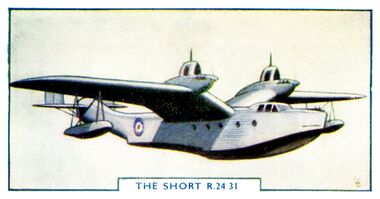Short Monoplane Flying Boat, Knuckleduster (Britains 1520)
| in storage |
|---|
Short Monoplane Flying Boat, Knuckleduster (Britains 1520) |
|
|
| location: |
|
in storage 1937 - 1939 |
1938: Cigarette card showing the Short R.34/21 "Knuckleduster2," issued by Godrey Phillips [image info]
A blue and silver gull-winged Short Monoplane Flying Boat, Britains Ltd. model number 1520. According to the "Great Book of Britains", this model was manufactured from 1937 to 1939, which seems a little late for a prototype that first flew in 1933 and was retired in 1938.
Rarity
This is a very rare model: because of its high initial cost, the brief production run, the fact that it wasn't to Britains standard 1:32 scale, and the fact that it wasn't a model of a popular aircraft conspired to make this a poor seller for Britains, and when it was discontinued, it's likely that not that many had been sold.
Oddities
This example doesn't have the small wheels that were present on the Britains production versions.
The model has a thin axles connecting the engines which wasn't present on the original plane: this has a pulley-heel in the centre, the idea being that the plane runs along a cord using the pulley, the axle rotates, and inside the hollow engine casings, some sort of gearing system then makes the propellers spin. This internal gearing seems to be missing. There is also supposed to be a second pulleywheel above the tail: this seems to have been lost, the small (threaded?) hole for the screw-in pulley mounting is present.
Protoype?
A number of factors suggest to use that this example might actually have been a prototype for the production models.
- The body of the model is solid lead. Production models would have been hollowcast. This raises the question of whether the body is a reproduction. However, the rest of the model seems original, and in order to take a mould to cast a reproduction, one would have to effectively destroy an original ... and then source of make all the other pieces.
- the floats have additional supports soldered to them. It seems unlikely that anyone trying to make a reproduction would deliberately add extra pieces. The real Knuckduster experimented with heavy vertical supports, and thinner dual angled supports – this has both.
Our guess is that Britains would probably have made a few prototypes as tests before settling on a final design, and that this might be one of those.
Design
This was a big, expensive model with a fourteen-inch wingspan, and very heavy.
The Short R34/21 S.18 "Knuckleduster"
Although the "Knuckleduster" never made it into proper military service, it served as a stable testbed for technologies later used in the Empire Flying Boat and Sunderland Flying Boat.
The Short S.18 was one of the most distinctive and memorable flying boat designs of the 1930s, due to its unusual "hunched shoulders" design, reminiscent if the shape of the shoulders of a large seabird.
The "Knuckleduster" never went into production, and only the prototype was built. However, the shape was so distinctive that publications liked using pictures of it to add a bit of variety to their pages, and the aircraft became reasonably well known through photographs.



